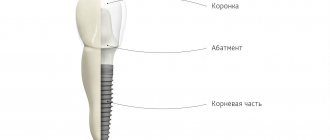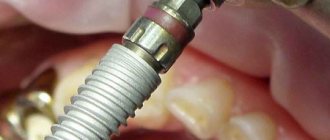After implantation, a realistic copy of it appears in place of the lost tooth. Both in appearance and in feel, the new and old units of the series are almost identical, so the patient quickly gets used to the prosthetic structure. And over time, he often forgets that he needs to treat her with care. The result may be the following situation: the crown has fallen off the implant and now it is unclear what to do with it. In this case, you should not be upset, nor should you try to secure the prosthesis yourself, using glue or other improvised means.
How long does it take to insert a tooth?
The duration of the tooth restoration procedure depends on the restoration method. If the tooth is destroyed by no more than 1/3 and has a intact root, it can be restored directly in the patient’s mouth in one visit. If the root is preserved and the crown part of the tooth is destroyed by more than 1/3, you can resort to microprosthetics, which is also performed in one visit.
If the coronal part is significantly destroyed and the tooth must be removed, implantation or installation of a bridge structure supported by adjacent teeth is indicated. If the patient chooses implantation, then modern protocols make it possible to restore the integrity of the jaw row in one or two visits. The traditional protocol involves allowing the implant to heal for about six months and, if osseointegration is successful, installing a permanent crown.
Prevention of prosthesis installed on an implant falling out
For the normal service of the implant and crown, it is important to follow the dentist’s prescriptions and recommendations after surgery, as well as follow the rules for using the structures. Correct and sufficient oral hygiene is of great importance. You should not neglect brushing your teeth in the mornings and evenings. After every meal you need to rinse your mouth. You can eat anything, but the side of the implant should be protected from too much stress. It is better not to eat foods that need to be chewed, chewed, or chewed with force.
How does the second stage of dental implantation proceed?
The second stage of dental implantation is marked by the installation of a gum former. The purpose of the implant system element is to create a beautiful contour of the gum line. With one-stage implantation, the former is installed immediately after implantation. The construction is removed at the second visit and replaced with a temporary crown on the abutment. With a traditional two-stage protocol, the former is installed only after 4-6 months, when the implant has successfully taken root. In this case, a second operation is performed, during which the gingival flap is excised, the plug is removed from the implant, the former is fixed, and the wound is sutured tightly.
Symptoms
The patient may not yet understand that the implant is already loose, but other characteristic symptoms may tell him about this. Loosening of the implant is always caused by weakening of the gums or bone, so the phenomenon is often accompanied by swelling and redness of the soft tissues, bleeding and suppuration, as well as pain. In addition, there is a constant unpleasant odor from the mouth, which cannot be eliminated even by regular brushing of teeth.
The survival rate of high-quality implants remains at the level of 90-95%, that is, some risk of rejection remains in any case. It is important for the patient not to lose vigilance, because the problem can appear either after a few days or years later. Unpleasant symptoms detected at any time after implantation are always a reason to immediately consult a doctor.
How long can you wear implants without crowns?
If we consider a two-stage implantation protocol, then you will have to walk without permanent crowns for six months. To restore the aesthetics and chewing function of the dental system, temporary plastic crowns are fixed 2-3 months after surgery.
Permanent crowns are installed only after successful osseointegration of the implant into the bone tissue. Temporary crowns should be worn not only for aesthetics, but also to prevent atrophy of the bone tissue of the jaw arch and destabilization of the titanium rod.
Procedure after a crown falls out
Regardless of the reasons why the crown on the implant fell off or became very loose, you should neither panic nor try to leave “everything as it is.” Immediately after the incident you need to:
- remove the detached crown from the oral cavity;
- inspect it, if necessary, clean it of food debris and place it in a dry container;
- rinse the mouth with an antiseptic solution;
- cover the implant with a sterile cotton swab;
- If you are bothered by pain, take an analgesic.
After this, you need to go to the dentist as soon as possible. If you can only get an appointment with a doctor the next day, you need to avoid chewing on the side of the implant and avoid solid foods for now. After eating, it is advisable to rinse your mouth with an antiseptic solution or just clean boiled water.
What happens if the implant does not take root?
Implant failure is difficult to prevent. The causes of the pathology may be peri-implantitis, smoking, non-compliance with medical recommendations in the early and late postoperative period. If acute rejection occurs, removal of the titanium rod is indicated. Re-implantation is possible only after complete healing of the wound. Rejection can develop several years after the permanent crown is installed. A number of external and internal factors can provoke a pathological process and destabilization of the implant.
What are the reasons for implant loosening?
In some cases, the doctor who performed the implantation is to blame for loosening the implant. His list of mistakes includes:
- incorrect choice of rod size;
- overheating of tissues during preparatory procedures;
- ignoring requirements regarding sterility;
- ill-conceived placement of the structure in the oral cavity;
- unacceptable superficial examination of the patient’s current condition;
- the use of low-quality or simply counterfeit insert systems.
Much more often, the culprit of his own problems is the patient himself, who naively thinks that following the doctor’s instructions after surgery is not necessary. Here are typical regime violations that lead to loosening of the structure:
- self-medication;
- refusal to perform procedures prescribed by a doctor, even partially;
- excessive heating or cooling of the body during the recovery period;
- negligent attitude towards oral hygiene;
- eating solid or tough foods soon after implant placement, earlier than allowed;
- refusal of regular examinations by the treating dentist;
- hiding from the doctor health problems that are a contraindication for implant installation.
It also happens that the implant begins to wobble due to the patient’s health deteriorating. This happens due to some injuries, infection with tuberculosis or the manifestation of cardiovascular diseases, as well as a general deterioration of immunity, especially against the background of HIV infection. Tumor processes in the body also significantly worsen the prognosis.
How they can help in dentistry
Each case is individual and requires mandatory diagnosis by an orthopedic dentist. The fastest and most cost-effective option is to clean the stump and prosthesis of old cement, treat it with an antiseptic, and glue the crown back on.
A longer and more expensive option for help is to treat caries, fill and strengthen the canals, then take impressions, according to which a new prosthesis will be made in a dental laboratory.
In the case when the tooth root is completely unsuitable for prosthetics (installation of a pin, stump insert) due to severe destruction, it is removed. Therefore, the patient has only 2 options - to place an implant or a classic bridge, but in the latter case, the adjacent teeth will have to be ground down and the nerves removed from them.
The most important points in implant-supported prosthetics
Oddly enough, planning for implantation begins not with the implantologist, but with the orthopedist - this is the doctor who will subsequently install the orthopedic structure on the implant. It is he who first decides what kind of structure it will be and how many, as well as in what area he needs support to install this structure.
Before transferring the patient to the implantologist, the orthopedist determines:
- The type of future crown.
- Abutment type.
- The type of crown fixation is screw or cement fixation.
- Method of taking an impression.
- Timing of prosthetics.
That is why at the Trilogy clinic, doctors, if necessary, conduct joint consultations to choose the most optimal treatment plan.
Signs
Signs of the onset of rejection, which can cause implant loss, include:
- swelling of the gums, deterioration of the condition a week after installation of the prosthesis;
- redness of the mucous membrane;
- acute, severe pain, the appearance of the syndrome after exercise or spontaneously;
- bleeding at the site of implantation of the artificial root;
- pus, unpleasant, putrid odor;
- the structure becomes movable;
- increase in body temperature, the Patient's condition worsens.
In the absence of treatment, deformation of the gums develops around the affected area, soft and hard tissues become necrotic. In case of rejection, spontaneous removal of the artificial root is observed, which is accompanied by severe pain.
Or maybe it’s not the implant itself that’s loose, but the crown?
If yes, then this is the best news, because in this case you just need to tighten the screw connecting the abutment and the crown. To do this, you also need to go to a specialist, but this is not long and not expensive. It happens that the cement does not hold the crown - then it is removed and the cement layer is replaced, which is also not so scary. The main thing is not to delay these procedures, because bacteria may begin to multiply in the cavity formed in the mouth, and we do not need this at all. In addition, you cannot be sure that the problem is exactly that, in its mildest form. There is an opinion that a loose abutment, unlike a loose crown, almost always provokes severe pain, but it is still better not to engage in self-diagnosis and immediately consult a doctor.
When should you not reinstall a fallen crown?
There are several such cases:
- When the crown fell out along with part of the pin.
- When, together with artificial elements, the entire dental unit fell out. This can happen, for example, with severe forms of periodontal disease.
- When the crown has lost its integrity.
- When the structure was initially fixed in cement. It is essentially impossible to completely remove its remains even with the help of dental equipment. And in this aspect, the screw fastening clearly wins - such difficulties will not arise with it.
- When caries affects the tissues of the “crowned” tooth and breaks the tightness of the connection. The only workable solution here is to first treat the caries and then take impressions to create a new crown.
Solving a problem at home: what to glue it with and is it possible to do it?
If a crown falls out, many people search on the Internet for how to glue the product and how to fix it at home. To do this, some users advise using different means: superglue, chewing gum, Vaseline and toothpaste, cream for fixing removable dentures or specialized cement, which can be bought at the pharmacy.
Is it possible to insert fallen crowns yourself using the means listed above? You can't do this. Regular glue is toxic and can cause tissue inflammation; chewing gum will become an excellent source of food for bacteria in a short period of time.
Cream for removable dentures is a temporary solution that will help eliminate the problem for 1-2 days, but during this period there will be a risk that the structure will still come off (for example, the fixation of the composition may weaken due to drinking hot drinks) and you will not If you notice this, swallow it.
As for specialized cement, you must first carefully remove the remains of the old glue from the crown, but this is impossible to do at home (sometimes this is not possible even with specialized dental equipment, and then the structure must be replaced). If during installation the glue gets on the gum or, even worse, under the gum, and you cannot remove it, then inflammation cannot be avoided. Among other things, during manipulations you can damage the tooth stump or the prosthesis itself.
Even with the help of specialized cement, it is technically impossible to carry out the procedure correctly and safely at home, and there may be inflammation under the prosthesis or on the root that needs to be treated. Amateur action in this matter can lead to the need to remove the tooth later.
Adaptation to new crowns and dentures.
What do you need to know?
Modern dentistry has made great strides, with its help you can make your smile truly radiant.
However, many types of treatment require patience and endurance from the patient. Adaptation to a denture takes a lot of time. Therefore, it is necessary to listen to specialists who give valuable recommendations on how to get used to dentures in a short period of time. When the prosthetics are completed, we recommend not to eat hard food for a couple of days - it’s not quite familiar yet and you can accidentally bite your lip, cheek or tongue. While eating, chew slowly, control the movement of food in different directions, as well as the position of the lips and tongue while eating (to avoid injury to the mucous membrane). Eliminate hard and viscous foods (nuts, crackers, crackers, hard sausages, persimmons, chewing gum, etc.). Remember, the facial and chewing muscles are not yet ready to function in a new position after prosthetics. Xerostomia (dry mouth) or increased salivation may occur.
There is a feeling of limited space for the tongue.
After restoration of the height (increase) of the bite, a restructuring of muscle reflexes occurs.
Irritability, sleep disturbance, and minor discomfort in the muscles and temporomandibular joints are also possible. The first few days the diction may even be changed. This happens when prosthetics involve several front teeth. Which decisively influence, and indeed create, diction and phonetics. To speed up adaptation, more training is recommended: talking more, chatting on the phone, perhaps using myogymnastics, i.e. talk in front of the mirror. The more training, the faster pronunciation is restored.
Often these phenomena disappear after 2 months of using orthopedic structures.
We must also remember that there are teeth under the crowns, and while crowns can withstand barbaric treatment of them, teeth cannot always. Therefore: do not limit food intake and treat the crowns as if they were your own teeth. Eat as usual, do not conduct experiments (open bottles, chew bones, metal or wires), brush as you would your teeth.
Clean and care for crowns in the same way as other teeth. No additional care required. After eating, you can rinse your mouth with plain water to wash away all the remaining food from under the artificial teeth. If it gets stuck between the crown and an adjacent tooth, then clean it with floss (dental floss), a brush or an irrigator.
Food should not get under the crowns themselves. But for artificial teeth - maybe. Let me explain.
Artificial teeth can be made very tightly to the gum. Modern impression materials and technologies make it possible to do this easily. But in this case, food will certainly get between the artificial tooth and the gum. The gums are very pliable. While chewing food, small pieces can move it away and squeeze between it and the artificial tooth. There is no way to get them out of there. This will cause gum inflammation over time. Everyone knows that any inflammation is accompanied by edema, that is, an increase in volume. The gums will “hug” the remaining food. It will be impossible to get to him at all. Inflammation will increase, and the gums will swell even more. It's a vicious circle. This can only be stopped by removing the remaining food. But it’s unlikely to be possible to do this on your own.
To prevent this, a distance is created between the artificial tooth and the gum. Officially, this gap is called the flushing space. This was not invented by us - this is done all over the world. That is, when making crowns with artificial teeth, rinsing spaces are required. They make it possible to wash away all food residues by simply rinsing with water.
It is important to know that... a) Brush your teeth and dentures regularly, at least twice a day. Brush the contact and side surfaces of the bridge with a toothbrush in the same way as natural teeth. b) To clean the spaces between teeth, dental floss (floss), toothpicks, special interdental brushes, brushes and an irrigator can be used. Clean the inner surface of the denture, as well as the interdental spaces of the bridge, especially carefully. c) The surface of the dental crown and adjacent gums is best cleaned with a brush, using regular toothpaste (but not abrasive, which can damage the surface of the denture). At the same time, try to actively carry out sweeping movements at an angle of 45°, directed from the gums to the cutting edge or chewing surface of the prosthesis. d) After cleaning the denture, it is recommended to rinse the oral cavity thoroughly with water or mouthwash.
We wish you patience and health!
Do not forget that the success of treatment now largely depends on you.
Performed by orthopedic dentist S.V. Mogilnikov.
Prevent it from falling out
Much depends on the work of the orthopedist and dentist, but not everything. The crown will last longer if after prosthetics you strictly follow a few simple rules:
- brush your teeth regularly, use mouthwash, dental floss, and irrigator;
- eliminate the risk of tooth damage due to their improper use;
- Visit a hygienist at least once every six months.
Losing or breaking a dental crown causes discomfort and puts the health of your remaining teeth at risk. Therefore, to prevent trouble from happening unexpectedly, chew your food more carefully, and most importantly, undergo medical examinations. The latter will allow you to detect emerging problems in a timely manner and preserve the crown for as long as possible.
Abutment. Which options should I choose?
The abutment is the middle part connecting the implant itself and the crown. Sometimes the abutment is immediately attached to the implant, but most often it is fixed separately. Abutments can be standard or custom made.
- Titanium abutments.
Most often they are used with metal-ceramic crowns or with zirconium dioxide crowns, but in the area of chewing teeth.
They can also be made individually - in this case, after taking an impression, the doctor transfers it to the laboratory, and there an abutment is made on a special milling machine. Or classic - in this case it is a factory-made abutment suitable for the installed implant.
A standard abutment is cheaper than a custom abutment and is often sufficient. An individual abutment is made if the standard one presses on the gum, which can lead to gum inflammation and peri-implantitis in the future.
- Zirconium abutments.
Zirconium abutments are better than titanium abutments in several respects:
The most important thing is aesthetics. Titanium abutments can often make the gums appear blue or the zirconia crown appear gray, so for smile restorations, a zirconia abutment is a better option.
Another important factor is that dental plaque is less fixed to zirconium dioxide, thereby reducing the risk of loss of gum mucosa around the crown.
Why does the prosthesis fall?
Orthopedics is one of the most complex areas of dentistry. For high-quality installation of a prosthesis, in which the likelihood of the crown falling off is minimal, it is necessary to take into account many factors. The size of the lost fragment, individual characteristics of the bite, proper sanitation of the oral cavity before treatment, correct calculation of height - the surgeon must take these and other aspects into account when making prosthetics. A dental bridge is a thin and rather fragile product, especially when made from ceramics. It has increased whiteness and remarkable aesthetic qualities, but, according to statistics, most often it happens that a ceramic crown comes off. The geometry of the turning of the element is of great importance: the more parallel the walls are (the less taper), the lower the likelihood of going to the doctor because the crown has fallen off. Among other reasons for force majeure, the following factors should be noted.
- External influence, for example, sharp pressure when eating solid food. You need to be very careful when biting into apples or chewing nuts with dentures in your mouth.
- Mechanical damage due to injury or impact. This can happen when playing sports or moving awkwardly.
- Low-grade cement that cracks and crumbles over time. You need to use only high-quality mixtures from the world's leading manufacturers.
- Insufficient sanitation of the oral cavity. If saliva or a particle of food remains under the denture, it is possible that the problem of “crown falling off” will soon become urgent.
- Incorrectly calculated biomechanics, in which the prosthesis begins to balance on the base. Proper grinding is an indicator of the dentist’s qualifications.
- Development of caries under orthopedic construction. An infected cavity destroys the enamel, reducing adhesion to the prosthesis.
ON A NOTE! After prosthetics in our clinic there are no such incidents that the crown falls off. Classy specialists, high-tech equipment, and enormous experience eliminate any unpleasant circumstances for clients. But after operations performed in other medical institutions, we often accept patients. Doctors make every effort to re-sharpen the element, if possible, and reliably install the structure. After our work, the question “why the crown fell off” does not arise among visitors.
What size should the ground base (stump) be for installing a crown?
- as high as possible: in this case, the structure will effectively withstand lateral loads (when the jaw moves to the sides) and will not break along with the tooth,
- as wide as possible, have parallel side walls (i.e., close in shape to a cylinder): many dentists grind the stump in the form of a “herringbone” or cone, leaving the top thin and not resistant to loads. The key to high-quality fixation is the maximum preservation of your own tissues and the correct shape, which allows you to withstand normal chewing pressure,
- at the base of the ground stump there should be a ledge or a small step, which ensures a tight fit of the crown to its own tissues in the gum area.











